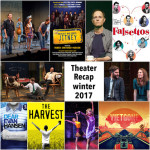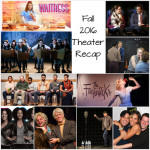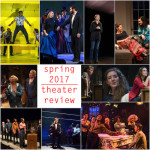I’ve seen about 20 shows in New York City since the end of June and I’m going to recap the first 10 in this post. Sorry for the delay, as half of these shows have already closed… when I write part two in a few weeks the info will be much more fresh! I also visited a bunch of theater festivals over the summer and I will have a write-up on those shows soon.
Out of the 10 shows reviewed in this post – two were on Broadway, seven were off-Broadway, and one was off-off Broadway. Five were musicals and five were plays. Four were written by women and six were written by men. Three were written by people of color.

Without further ado…
 Sweeney Todd by Stephen Sondheim and Hugh Wheeler (off-Broadway)
Sweeney Todd by Stephen Sondheim and Hugh Wheeler (off-Broadway)
The Barrow Street production of Sweeney Todd has been running for months now, and thankfully it keeps extending so you have more time to see it (it recently recouped its $1.22 million investment). This immersive production is set in a dingy London bakeshop; the audience sits at long tables as the action takes place around them (there are also traditional seats at the back of the theater and mezzanine level). I purchased a “twisting view” seat at a table for $85 which I was quite pleased with – it was a genuine thrill to have the actors sing and perform in such close proximity, even jumping onto the tables at various points throughout the show. Some of our best stage actors take on the iconic rolls of Mrs. Lovett and Sweeney Todd – Carolee Carmelo and Norm Lewis (who has since been replaced by Hugh Panaro). The intimate nature of this setting allows for a more immediate connection between audience, actors, and musicians. This already eerie tale feels even more so when experienced in such a confined setting. If you wish, you may select a seat that includes a pre-paid meal (around $22 extra) – those audience members arrive early and enjoy meat pies made by a former White House chef, served in the pie shop which will then become the stage for the performance. I did not indulge, however it sounds like a fun way to feel even closer to the story by engaging your sense of taste. The morning I saw the show (last June) I found out that my high school theater teacher had passed away. He is the person who introduced me to Sweeney Todd back in 1999 and he was very much on my mind during the show – without his influence, I likely would not have been in the city seeing two shows that day. Sweeney Todd has been extended through February 25th – do yourself a favor and get thee to Barrow St. Theatre to experience this classic in a unique setting. Tickets are outrageously expensive at $140, however I was happy with my $85 “twisting view “seat. I did have to turn my neck at times to see much of the action, but it was worth it for that proximity at that price.
 Baghdaddy by Marshall Pailet and A.D. Penedo (off-Broadway)
Baghdaddy by Marshall Pailet and A.D. Penedo (off-Broadway)
Baghdady is a musical comedy about the events immediately precipitating the start of the Iraq war. We have gathered for an Alcoholics Anonymous-style meeting in the church basement of St. Luke’s Theater (there are donuts and coffee for the audience, and everyone wears a name tag) as we witness these characters unburden themselves by confessing exactly how their actions contributed to the start of this war. We see all of these scenarios play out in flashbacks throughout the show – a low-level CIA employee hypothesizes about how weapons of mass destruction might be used; he publishes this theory on-line. Shortly thereafter, a refugee arrives in Germany professing that he knows about a plan to use WMD, which it turns out he made up after reading that CIA employee’s account on the Internet. We meet the CIA executives who then investigate the refugee’s story and bring it to a higher level of scrutiny for their own personal gain, and things spiral from there into full-on conflict. In total, Baghdaddy is actually a quite compelling (if reductive) view on how this war got started. The actors were terrific – Ethan Slater, the lead of the new SpongeBob Broadway musical, plays one of the CIA operatives. Larisa Oleynik (from The Secret World of Alex Mac, which anyone my age will remember) plays another CIA operative. Each supporting role is played by a deliciously talented actor. The action happens in and around the audience (as we are part of this “support group for people who started the Iraq War”) which makes it a rather intimate staging. As you might imagine, there is much humor mined from the juxtaposition of a serious event as told through the eyes of musical comedy. This show previously ran under the obnoxious title “Who’s Your Baghdaddy,” to which the New York Times called it “a terrific musical with a terrible name.” It has finished its most recent run in NYC but will hopefully have more life.
 Spamilton by Gerard Alessandrini (off-Broadway)
Spamilton by Gerard Alessandrini (off-Broadway)
What a joy this was. The creative team behind Forbidden Broadway has released the latest installment of their show – I had expected it to be entirely about Hamilton, and was pleasantly surprised to discover that they’d updated the content to include references to this recent Broadway season. The show has scheduled runs in Chicago and Los Angeles and I’m curious how these NY-centric jokes will land there – like the bit about Bette Midler giving Lin-Manuel Miranda hard-to-get Hello Dolly tickets only to reveal they are for Tuesday night when her standby Donna Murphy goes on as the lead. That had me in stitches but I don’t know if it will go over the heads of audiences outside of NYC who think they’ve come for a night of exclusively Hamilton references. But I loved how cleverly they wove in this updated commentary within the framework of Hamilton. Also clever is how they wrote the spoof not around the actual story line of Hamilton, but more around Lin-Manuel Miranda, and how his life has changed in writing such an uber-popular hit. Extra creative points for changing the context of many Hamilton numbers… two that stand out are: 1) “How to Say No to This” where J. Lo, Beyonce, and Gloria Estefan each try to persuade LMM to write them a hit song but he’s too busy fielding other professional opportunities, and 2) “I Wanna Be in the Film When it Happens” about how all the cast members want to keep their roles for an eventual blockbuster. Great conceits. Also, the cast has stellar pipes, and I suspect each of them will do well on Broadway whenever they leave Spamilton. Wouldn’t it be a trip to see some of them actually move into the roles in Hamilton that they’ve been spoofing all this time?
 Say Something Bunny by Alison S.M. Kobayashi (off-off-Broadway)
Say Something Bunny by Alison S.M. Kobayashi (off-off-Broadway)
This is one of the more unique and fascinating theatrical experiences of 2017. I’d been told this performance is akin to attending a live episode of Serial podcast – which I would describe as very accurate. Audience members – only 24 in total, a very small crowd – sit around a table as our narrator (who is also the playwright) presents us with a transcript of audio recordings she got through a friend-of-a-friend from an estate sale. The audio is from a wire recorder and our narrator was able to deduce that the recordings began in 1952 based on what the people were talking about. Here is the gist: a family gathers shortly before Easter in 1952 for a dinner with their neighbors, who are about to move away. One of the sons, David, is in his late teens and has recently purchased the wire recorder for a steep $150. A series of scenes follow, as David records a Thanksgiving dinner and a few other moments with his family. From this low-quality recording, our narrator is able to piece together who all of the people connected to the family are (around 16 in total) and trace their identity through census records and more. She identifies context clues – lyrics of a song spoken by one character, references to popular commercials of that era, and other seemingly subtle moments that actually reveal a whole world of detail when examined closely. The purpose of this performance is for her to present the audio (audience members follow along reading a transcript and visuals are presented via projector) while she deduces clues about these peoples’ lives – is someone sick with cancer? Is someone gay? How long did the family’s dog live? The narrator susses out nuanced guesses as to what is going on just below the surface of the recording. Audience members around the table are further drawn in when our narrator assigns us each a character to “play.” No audience participation is required – she simply points to the audience member standing in for each ‘character’ as she explains more details about each person. (I was Stella, the grandmother of the boy who made the recordings.) The narrator occasionally does impressions, dons costumes, sings along to songs, and uses a live video feed – these theatrical flourishes beef up the evening to turn it into more of a performance rather than just a presentation, but sometimes they feel superfluous. My takeaway from this experience is that everyone has a narrative, and even the most pedestrian ones are made interesting when you have to dig around for the details. It was depressing to a point, to consider how fleeting this life is, and how if we jump 65 years in the future, will anyone care about the tiny moments of each of our lives? This particular family has had their story immortalized on stage based on just a few scant audio recordings – how will that translate in the future when so much of our lives are now documented for posterity on our phones and social media? Who will care to look through the monstrous amounts of digital clutter and dig up stories on strangers? Or to look at this from a less depressing angle, there is more emphasis to enjoy life NOW – if no one will remember our dinner conversations in 65 years, then the only thing that matters is how we make others feel in the present. To that regard, Say Something Bunny (an ingenious title based on a moment in the audio recording) is a reminder to go home and hug your loved ones today, because we are all just stardust in the big picture. As of this writing, the show runs through Jan. 28th.
 Pipeline by Dominique Morisseau (off-Broadway)
Pipeline by Dominique Morisseau (off-Broadway)
This Dominique Morisseau play at Lincoln Center has been on my radar since it was first announced. After being so moved by Skeleton Crew at The Atlantic last year, I resolved to see everything Morisseau writes going forward. Pipeline follows Nya, a woman who teaches at an inner city public high school. Her son Omari goes to a private school in the suburbs. When he gets in trouble for a physical altercation with a teacher who unfairly presses him to talk about race during class, Nya must confront this intersection of race, privilege, education, and how its forces have caused her world to spin out of control. This powerful play is elevated further by Karen Pittman’s performance as Nya, who is weary and struggling and fiercely concerned about her son’s future. I hear that this show has been recorded and may air on PBS in the future. Hopefully region theaters will program it into their seasons, too.
 Natasha, Pierre, and the Great Comet of 1812 by Dave Malloy (Broadway)
Natasha, Pierre, and the Great Comet of 1812 by Dave Malloy (Broadway)
I was very glad to see this show before it closed… but I don’t have the best things to say about it. While very interesting from a technical standpoint, it has little narrative value. This show is all style, circus, spectacle, and shine over substance. It’s based on a few chapters of Tolstoy’s War and Peace which basically reduces to a shallow love story. The show is a feat of directing and design to make it all come together, but without the storytelling heft to back it up, why should we care? The plot felt noticeably weaker than when I first saw the show back in January of 2014 in a tent in Times Square – and, it should be noted, I really enjoyed that experience. But there is so little going on story-wise (it doesn’t get deep until the final two numbers of the evening) so a second viewing reveals just how shallow it is. I won’t say too much about the specific performance I attended because the details are not worth getting in to, but the sum total of my experience adds up like this: in the positive column, all design elements are rad and it’s cool to admire the overall direction… and in the negative column, the show lacks emotional depth / character development, the theater staff/security made it feel like herding cattle just to enter the theater, producers were not transparent about cast changes at the performance I attended, producers have made sketchy decisions re: the show, and I felt sick throughout the performance which inhibited how much I got into the ‘immersive’ aspect of the direction. If it had been my very first time seeing the show and I’d been feeling better and knew in advance that Ingrid Michaelson would be out, I think I would’ve liked the experience much better. The show has since closed.
 Groundhog Day by Tim Minchin and Danny Rubin (Broadway)
Groundhog Day by Tim Minchin and Danny Rubin (Broadway)
Groundhog Day was an unexpected delight. I had zero intent on seeing this show – it’s another entry in a long line of musicals based on movies, and that concept is tiresome to me. But the show was not shy about leaning towards the dark side, and composer / lyricist Tim Minchin (Matilda) has a one-of-a-kind voice that produces memorable lyrics. Lead actor Andy Karl is very much at home in this role; he is on-stage almost the entire show and makes it look effortless. Kudos to director Matthew Warchus for staging inventive moments, like the car chase scene which got lots of applause. And since the entire show hinges on the conceit that same day is repeated over and over with a series of variations, each scene must be very precisely staged. Despite the behavior of matinee audiences (the woman in front of me took a call on her cell phone and the people behind me kept talking throughout the show) I left having very much enjoyed Groundhog Day. The show has since closed.
 To Peter Pan on Her 70th Birthday by Sarah Ruhl (off-Broadway)
To Peter Pan on Her 70th Birthday by Sarah Ruhl (off-Broadway)
A new Sarah Ruhl play! She wrote this as a 70th birthday gift for her mother, who starred in a local production of Peter Pan in Davenport, Iowa during her youth and even met Mary Martin when she came through town once. So the themes of family and the passage of time run strong throughout this play. I didn’t connect to it as much as I would’ve liked, but after reading an in-depth interview with Sarah Ruhl on the train ride home that night, it made more sense in context. She modeled this play after the structure of Japanese Noh drama, which is split into three movements and deals with ghosts: in act one you meet the ghost, in act two you recognize the ghost, and in act three you dance with the ghost. This play centers around a family of adult siblings as they deal with the loss of their father. In the first act, the siblings watch over their father’s hospital deathbed as he slowly passes away. (I found myself distracted by my own memories of loved ones on their deathbeds — it must be challenging for a playwright to write about something so universal and specific at the same time, and want your audience to focus on the story you’re telling them rather get lost in their real-life experiences connected to what’s happening in the plot.) In the second act, this family comes together for a meal following the father’s death. And the final act features them re-enacting Peter Pan as each sibling takes on a role and literally flies around on-stage. It sounds bonkers (I’m borrowing the adjective Sarah Ruhl uses in that interview linked above), but it works. This show has since closed.
 Too Heavy for Your Pocket by Jiréh Breon Holder (off-Broadway)
Too Heavy for Your Pocket by Jiréh Breon Holder (off-Broadway)
A moving new play about two young black couples living in Nashville in 1961. Despite the turmoil of the era and living in proximity to the deep south, these couples have carved out fulfilling lives – they are going to college, about to have kids, saving up money to buy a home. But when one of the husbands (Bowzie) decides to leave school to join the Freedom Riders, his marriage and the foursome’s friendship implodes. The Freedom Riders were civil rights activists who rode buses throughout the deep south as a form of protest against the non-enforcement of two supreme court rulings that deemed segregated public buses unconstitutional. It’s a powerful story about the price paid by the first waves of people who seek justice on any particular front – in this case, Bowzie could have just kept his head down and continued enjoying his own quiet existence in Nashville, but deep down he knows that to move racial progress forward in this country he must take action even if it brings him harm. The title refers to the price of hope. I was so moved by this play and highly recommend it. It runs through November 19th.
 Tiny Beautiful Things adapted by Nia Vardalos (off-Broadway)
Tiny Beautiful Things adapted by Nia Vardalos (off-Broadway)
You know that question, if you could have dinner with a handful of people living or dead, who would you pick? Writer Cheryl Strayed is at the top of that list, along with Sondheim and Lin-Manuel Miranda. So when I found out last year that her book Tiny Beautiful Things was about to be adapted by actress/writer Nia Vardalos (My Big Fat Greek Wedding) for the stage, it was on my radar to buy tickets. But it sold out so quickly that I had to miss its inaugural run at The Public Theater. Fortunately a second run was announced for this fall, and a friend at the Public very kindly invited me to the final dress rehearsal. I wasn’t entirely sure what to expect, as all of the source material was quite familiar to me from reading the book – it’s a collection of entries from the “Dear Sugar” advice column written by Cheryl Strayed in which she responds to a whole range of queries with tremendous depth and compassion. As I understood it before going into the show, Nia Vardalos plays the advice columnist Sugar, and three other cast members play all of the various letter writers. So would hearing those letters read on-stage translate into a compelling theatrical experience? Fortunately the answer is a resounding YES. As directed with sensitivity by Tommy Kail (Hamilton), Tiny Beautiful Things is an affecting emotional experience. I dare you to sit through that show and not sob your eyes out, as I did quite inelegantly from the front row. Cheryl Strayed’s beautiful words, as judiciously adapted and delivered by Nia Vardalos, ring with such emotional honesty that it feels like a downright religious experience to witness them. Much of Cheryl’s advice is connected to the grieving process, as she lost her own mother at a young age and wrote about her own grief journey in her best-selling memoir Wild. I don’t want to give away too much about the content of the letters delivered on-stage but will say that the most emotional one came from a father who lost his 20-year-old son when he was hit by a drunk driver. This show runs through December 10th.





